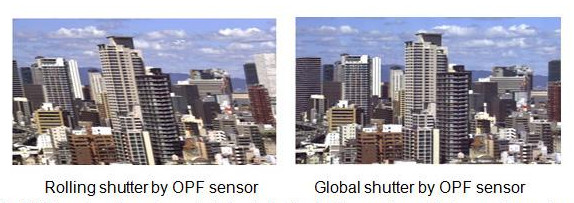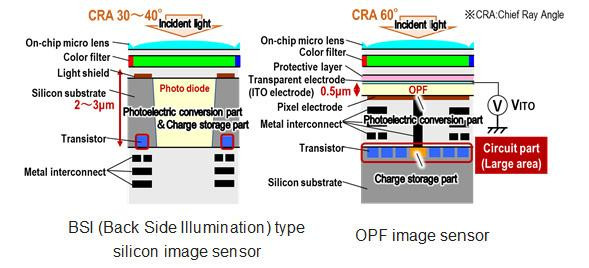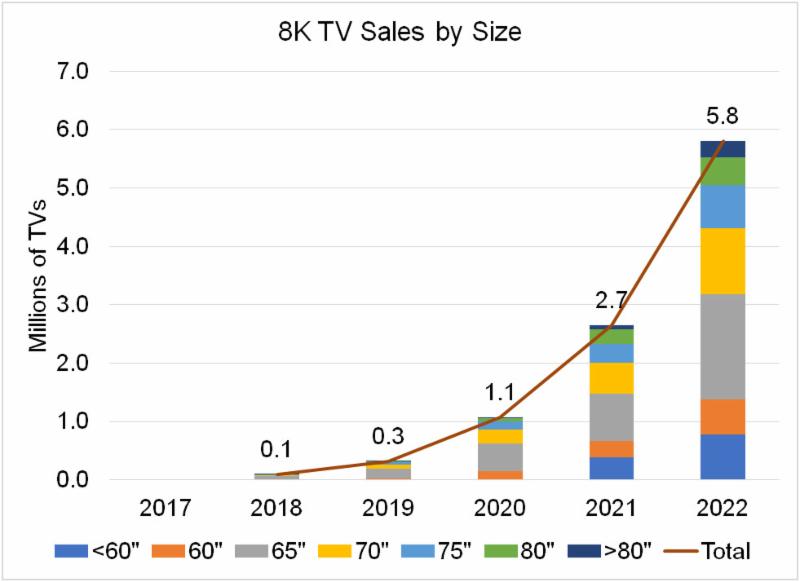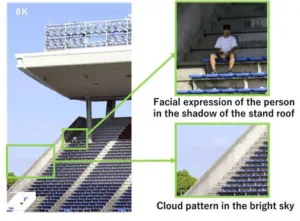Panasonic has announced a new 8K sensor that is kind of a hybrid between a CCD and CMOS sensor. The backplane is composed of CMOS, but an organic photoconductive film (OPS) covers the pixels. The big advantage of this approach – it can capture 8K at 60 fps using a global, not a rolling shutter.
Rolling shutters scan the exposure from top to bottom which can create motion artifacts for fasting moving objects in the scene. Global shutters are therefore preferred. In the example below, a fast pan of the skyline scene can result in tilted building with a rolling shutter.

The sensor also includes newly developed noise cancellation and is highly sensitive. This allows the sensor, when integrated into a camera, to capture bright and dark parts of the image simultaneously (HDR). It can also switch between high sensitivity and high saturation modes. Plus, it has implemented an electronic neutral density filter.
The figure below shows the structure of the OPS sensor compared with a backside illuminated CMOS type. It should be noted however, that Panasonic has just announced the sensor and not a camera solution.

The emergence of new 5G networks is expected to be very helpful for the distribution of 8K content. Qualcomm used MWC to run a simulation of what users might expect in terms of speed in San Francisco and Frankfurt once the 4G and LTE transmitters are switched over to 5G. The simulation took into account existing buildings and geography to get a realistic estimate. Frankfurt’s connections speeds on 4G were around 56Mbps but jumped to 490Mbps on 5G. In San Francisco, current data rates are around 71 Mbps, but jumped to 1400 Mbps on 5G.
An 8K/30 4:2:0 signal, which is the current broadcast standard, requires an uncompressed bandwidth of 29.86 Gbps. HEVC compression ratios in the 25:1 to 70:1 would therefore be needed to deliver this signal in these two cities if the simulations are accurate.
Also at MWC, Intel promised to offer Virtual Reality as an 8K 360º stream at the Tokyo 2020 Summer Olympics. As we reported on the PyeongChang Olympics (PyeongChang Olympics Showcase Next Generation Broadcasting Options (Part 1)), Intel fielded both 180º VR cameras in fixed locations and 360º VR camera on mobile platforms (such as skier’s heads). The results achieved mixed reviews with the fixed cameras trying to capture fast moving action not being well received but slower paced sports, like curling, fared better. The mobile platform VR content was popular, but only for very short periods.
Will Intel try to distribute this 8K VR over a 5G network? It has promised to build the world’s largest 5G network at the event, so we will see.
Of course, NHK has promised it will broadcast the 2020 Olympics in 8K having just completed the broadcasting of around 70 hours at the PyeongChang Olympics. Their production workflow was done in 8K/HDR but derivative versions in 4K.HDR and 4K/SDR were also generated, which is likely to be done at the 2020 event as well.
8K TVs are expected to include advanced features like HDR, wide color gamut and advanced upscaling. Native 8K content will be limited so upscaling will be a differentiating feature. The forecast for 8K TV sales by size is shown below. The Table of Content can be viewed here.


